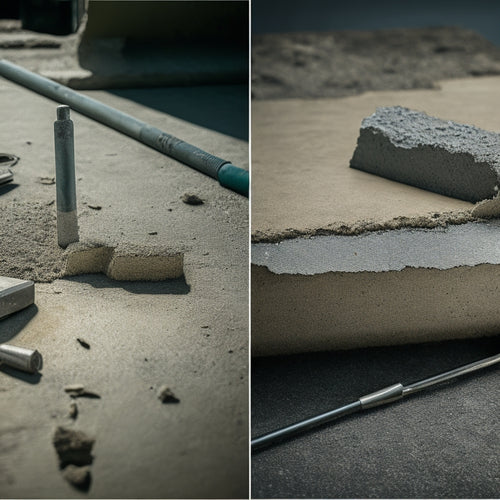
Essential Tools for Concrete Block Application Success
Share
You rely on the right tools to guarantee a successful concrete block application, as even a single misstep can compromise the entire structure's integrity. Essential tools include sealant guns and applicators, such as pneumatic, electric, and manual guns, with nozzles and tips in various shapes and materials. You'll also need surface preparation tools like cleaning solutions and wire brushes, as well as safety gear like goggles and respirators. Measurement and marking tools, like calipers and tape measures, guarantee accurate block placement. Finishing tools, like tampers and edgers, smooth out the surface, and sealant removal and cleanup tools help with post-application tasks. By including these tools in your arsenal, you'll be well on your way to a successful concrete block application – and that's just the starting point.
Key Takeaways
• A reliable sealant gun is crucial for efficient adhesive dispensing in concrete block applications.
• Proper surface preparation, including cleaning and prepping, ensures a strong bond between blocks.
• Essential safety gear, such as goggles and gloves, protects workers from hazards during concrete block projects.
• Accurate measurement and marking of concrete blocks facilitate precise cutting and fitting, ensuring project compliance.
• Finishing tools, like tampers and edgers, help achieve the desired surface texture and quality in concrete block applications.
Choosing the Right Sealant Gun
When applying concrete blocks, you need a reliable sealant gun that can efficiently dispense the adhesive. Selecting the right one depends on the specific requirements of your project.
There are various sealant gun types to choose from, including pneumatic, electric, and manual guns. Pneumatic guns are ideal for high-volume applications, while electric guns offer more control and precision. Manual guns are suitable for smaller projects and provide a cost-effective option.
Regardless of the type you choose, proper sealant gun maintenance is vital to guarantee peak performance and extend the gun's lifespan. Regularly clean the gun's barrel and nozzle to prevent clogging, and lubricate the moving parts to reduce wear and tear.
It's also essential to follow the manufacturer's guidelines for maintenance and troubleshooting. By selecting the right sealant gun and maintaining it properly, you can ensure a smooth and efficient concrete block application process.
Sealant Applicator Nozzles and Tips
When selecting a sealant applicator nozzle, you'll need to take into account the size options available, as the right nozzle diameter will guarantee a precise bead of sealant.
You'll also want to reflect on the tip material, as this will affect the durability and performance of the nozzle.
Nozzle Size Options
You'll need to select the appropriate nozzle size for your sealant applicator to guarantee a precise bead of sealant is dispensed onto the concrete block, as this directly affects the quality of the bond. The nozzle diameter affects the flow rate and pressure of the sealant, so it's essential to choose the right size for your specific application. A smaller nozzle diameter will result in a smaller bead size and lower flow rate, while a larger diameter will produce a larger bead and higher flow rate.
Nozzle shape variations also play a significant role in achieving the desired bead pattern. A round nozzle tip is ideal for producing a consistent, circular bead, whereas a flat fan nozzle is better suited for applying a wide, thin bead. You may also need to take into account specialized nozzle shapes, such as a 90-degree angle nozzle, for applying sealant to corners or tight spaces.
Tip Material Selection
Selecting the right material for your sealant applicator nozzles and tips is essential, as it directly impacts the durability and performance of the sealant bond, with common options including stainless steel, nylon, and polypropylene.
You'll want to take into account the specific demands of your concrete block application when making your choice. For instance, stainless steel nozzles and tips offer superior material durability and resistance to corrosion, making them ideal for harsh environments or applications involving abrasive materials. On the other hand, nylon and polypropylene options are often more economical and suitable for general-purpose use.
When evaluating material options, don't overlook color compatibility. Verify the tip material you select won't react with the sealant or affect its color, as this can compromise the bond's integrity.
You should also take into account the temperature range and chemical resistance required for your specific application. By choosing the right material for your sealant applicator nozzles and tips, you'll be able to achieve a strong, long-lasting bond that meets your project's exacting standards.
Cleaning and Prepping the Surface
Before applying concrete blocks, every inch of the surface must be free of dirt, oil, and other substances that could compromise the bond between the block and the surface.
You'll need to employ effective surface preparation techniques to guarantee a strong and durable bond. Start by sweeping or blowing away any loose debris from the surface. Next, use a pressure washer to remove dirt, grime, and oil stains. For tough stains, you may need to use a degreaser or a specialized cleaning solution. Be sure to follow the manufacturer's instructions and take necessary safety precautions when using these products.
Once the surface is clean, use a wire brush or broom to remove any remaining dirt or debris. You may also need to use a chemical etcher to roughen the surface and create a better bond between the block and the surface.
Essential Safety Gear and Equipment
Concrete block application demands a proactive approach to safety, and that begins with wearing essential gear and equipment that shield you from the hazards of the job. You can't afford to compromise on safety, so make sure you have the right gear before starting the project.
Safety goggles will protect your eyes from debris and dust, while protective gloves will provide grip and prevent hand injuries. A respirator mask is a must-have when working with concrete, as it filters out dust and particles that can cause respiratory problems.
Hard hats are essential for protecting your head from falling objects, and knee pads will save your knees from the constant kneeling and bending. Don't forget safety harnesses, which will prevent falls from heights and provide an extra layer of security.
Measuring and Marking Concrete Blocks
When measuring and marking concrete blocks, you'll need to verify the block size to guarantee accuracy.
You'll also need to master accurate marking techniques to transfer measurements to the block surface.
To achieve straight lines and precise cuts, you must develop a system for taking precise measurements and transferring them to the block.
Block Size Verification
Verify the block size by measuring each unit to confirm it meets the project's specifications, as even slight variations can affect the structure's integrity.
You'll need to check the block dimensions, including length, width, and height, to confirm they match the project's requirements. To do this, use verification techniques such as calipers or a tape measure to take precise measurements. Record the measurements to track any discrepancies and confirm consistency throughout the project.
When measuring, pay attention to any anomalies, such as warped or irregularly shaped blocks. These can impact the structure's stability and must be addressed before proceeding.
You may need to reject blocks that don't meet the specifications or consult with the supplier to resolve the issue. By verifying the block size, you can maintain control over the project's quality and confirm a structurally sound final product.
Accurate Marking Techniques
To guarantee accurate block placement, you must master measuring and marking techniques that facilitate precise cutting and fitting of concrete blocks, a fundamental step in maintaining structural integrity.
This requires using the right alignment tools to make certain blocks align correctly, reducing errors and waste.
When marking concrete blocks, it's important to use a straightedge or chalk line to create a precise reference line. This line serves as a guide for cutting and fitting blocks, making sure they fit together seamlessly.
Additionally, use a high-visibility marker or pencil to clearly mark the blocks, making it easier to identify cut lines and alignment points.
By employing these marking techniques, you'll achieve accurate block placement, which is critical for maintaining the structural integrity of your project.
Straight Line Measurement
You'll achieve precise straight line measurements by employing a combination of tools and techniques that confirm accurate block placement, starting with a sturdy straightedge or spirit level. These alignment tools ascertain your blocks are properly aligned, which is essential for a successful concrete block application.
Next, use a high-quality tape measure to take precise measurements, utilizing techniques such as measuring from a fixed point or using a story pole to maintain consistency. When measuring, always check your work by re-measuring and verifying your calculations to eliminate errors.
To further guarantee accuracy, use a laser level or string line to create a visual reference for your measurements. By combining these tools and techniques, you'll be able to achieve precise straight line measurements, resulting in properly aligned and accurately placed concrete blocks.
Smoothing and Finishing Tools
When working with concrete blocks, a set of smoothing and finishing tools is vital for achieving a uniform, professional-looking finish. These tools enable you to apply various smoothing techniques and finishing methods to guarantee a high-quality outcome.
| Tool | Function |
|---|---|
| Tamping tool | Compacts and smooths out freshly poured concrete |
| Edger | Creates clean, defined edges and corners |
| Float | Evens out the surface, removing any imperfections |
With these tools, you can achieve a range of finishes, from a rough, textured look to a smooth, polished surface. By mastering the use of these tools, you'll be able to tackle complex concrete block projects with confidence. Whether you're building a retaining wall, creating a patio, or constructing a foundation, having the right smoothing and finishing tools is essential for a successful outcome. By incorporating these tools into your workflow, you'll be able to achieve a professional-looking finish that meets your high standards.
Sealant Removal and Cleanup Tools
Concrete block projects often require the removal of old sealants or adhesive residue, and that's where sealant removal and cleanup tools come into play.
You'll need to select the right tools for the job, depending on the type of sealant you're dealing with. For example, you may need a solvent-based cleaner for oil-based sealants or a water-based cleaner for acrylic or latex-based sealants.
When it comes to cleanup methods, you'll want to take into account the surface you're working with. For rough surfaces, a stiff-bristled brush or scrubber can help dislodge old sealant. For smoother surfaces, a microfiber cloth or soft-bristled brush may be more effective. You may also need to use a scraper or putty knife to remove thicker layers of sealant.
Investing in a good quality sealant removal and cleanup toolset will save you time and effort in the long run. With the right tools, you'll be able to efficiently remove old sealants and prepare the surface for new applications.
This attention to detail will guarantee a strong, long-lasting bond between the concrete blocks and the new sealant.
Inspecting and Testing Sealant Joints
Your sealant joints require meticulous inspection and testing to verify the integrity of the concrete block structure. To ascertain sealant joint durability, you must examine the joints for any signs of damage, deterioration, or wear. This involves visual inspections, as well as testing for adhesion, cohesion, and flexibility.
| Test Method | Description | Frequency |
|---|---|---|
| Visual Inspection | Examine joints for cracks, gaps, or signs of wear | Daily/Weekly |
| Adhesion Testing | Measure the bond between sealant and substrate | Monthly/Quarterly |
| Cohesion Testing | Evaluate the internal strength of the sealant | Quarterly/Annually |
| Flexibility Testing | Assess the sealant's ability to absorb movement | Annually/Bi-Annually |
| Environmental Factor Testing | Expose sealant joints to simulated environmental factors (e.g., temperature, humidity) | As needed/Bi-Annually |
When testing sealant joints, consider environmental factors that may impact the joint's performance, such as extreme temperatures, humidity, or exposure to chemicals. By regularly inspecting and testing your sealant joints, you can identify potential issues early on and take corrective action to maintain the integrity of your concrete block structure.
Frequently Asked Questions
Can I Use a Regular Drill to Mix Sealant Material?
When you're preparing to mix sealant material, you might wonder if a regular drill will get the job done.
However, it's essential to evaluate the sealant's viscosity and the mixing techniques required. A regular drill can't handle thick, high-viscosity sealants, and may even introduce air pockets or inconsistent mixtures.
Instead, invest in a drill specifically designed for mixing sealants, ensuring a smooth, consistent application that meets your high standards.
How Often Should I Replace My Sealant Applicator Nozzles?
You should replace your sealant applicator nozzles regularly to maintain peak performance.
Inspect them daily for signs of wear, such as clogging or corrosion. Replace them every 3-6 months or sooner if you notice a decline in applicator performance.
Proper sealant nozzle maintenance is essential to guarantee consistent bead size and prevent material waste.
Follow these applicator performance tips to assure a smooth, efficient sealing process and maintain control over your work.
Are There Any Eco-Friendly Sealant Options Available?
Sifting through sustainable solutions, you'll find superb sealant options that sync with your eco-friendly ethos.
Biodegradable sealants, crafted from carefully curated sustainable materials, are now available. These innovative alternatives alleviate environmental anxieties, allowing you to construct with a clear conscience.
Look for certifications like EcoLogo or Greenguard Gold to guarantee the sealants you choose meet rigorous eco-standards, giving you peace of mind and a project that's both planet-friendly and professionally polished.
Can I Apply Sealant in Direct Sunlight or High Winds?
When applying sealant, you'll want to avoid direct sunlight and high winds, as they can affect the sealant's performance.
Temperature considerations are essential, as most sealants have ideal application temperatures between 50°F and 90°F.
You'll also need to adjust your sealant application techniques according to the weather. For instance, in windy conditions, use a lower viscosity sealant to prevent it from drifting or blowing away.
Always follow the manufacturer's instructions for specific temperature and environmental guidelines.
How Long Does It Take for Sealant to Fully Cure and Dry?
You're wondering how long it takes for the sealant to fully cure and dry.
Well, you should know that sealant drying times vary greatly depending on environmental factors. Temperature, humidity, and air circulation all play a role.
Typically, sealants can take anywhere from a few hours to several days to fully cure. In ideal conditions, you can expect it to dry within 24 hours.
However, it's essential to follow the manufacturer's instructions and wait for the recommended time to guarantee a strong bond.
Conclusion
As you stand back to admire your meticulously sealed concrete block structure, the harsh glare of the job site fades into the background, replaced by a sense of pride and accomplishment.
The rough, porous surface is now a sleek, impermeable barrier, protected from the elements.
Your toolbox, once a jumble of unfamiliar gadgets, has become an extension of your skilled hands, each tool a trusted ally in the quest for precision and perfection.
Related Posts
-

Top Concrete Resurfacing Tools for a Pro Finish
When it comes to achieving a professional finish in concrete resurfacing projects, you require the right set of speci...
-

Best Tools for Concrete Restoration and Repair
When tackling concrete restoration and repair projects, you need a range of reliable tools to achieve professional-gr...
-

Top Tools for Concrete Adhesion Success
When it comes to concrete adhesion success, you'll need to wield the right tools and techniques to guarantee a strong...


